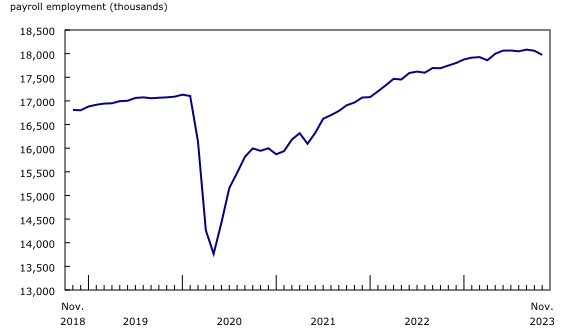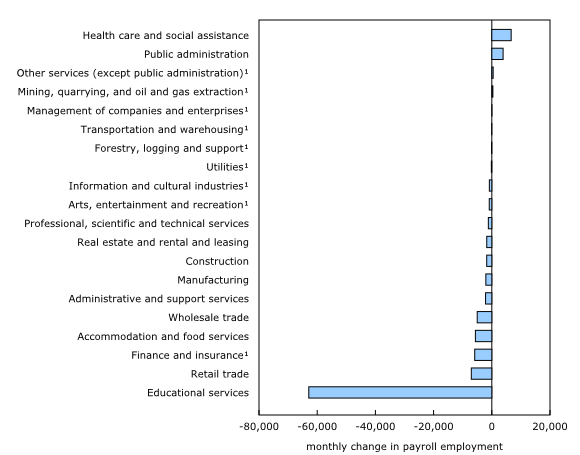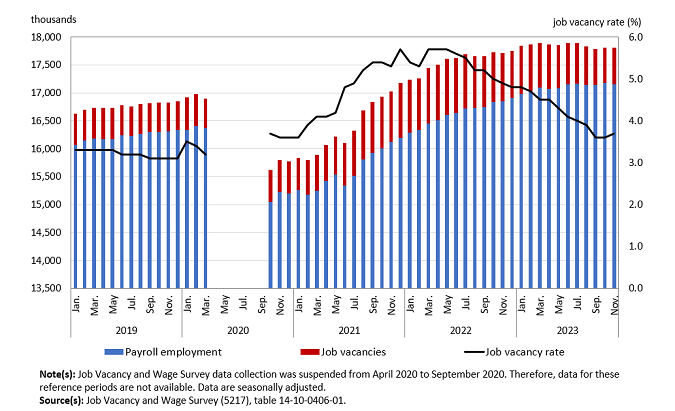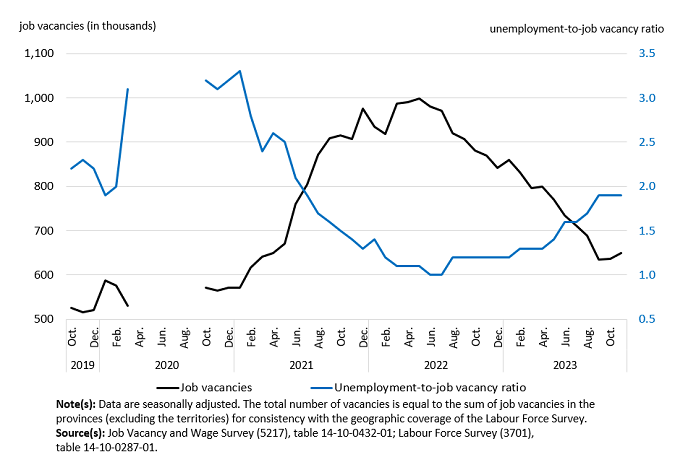Payroll employment, earnings and hours, and job vacancies, November 2023
Released: 2024-01-25
$1,228.07
November 2023
4.1% 
(12-month change)
$1,219.70
November 2023
3.3% 
(12-month change)
$1,027.14
November 2023
3.7% 
(12-month change)
$1,095.82
November 2023
6.2% 
(12-month change)
$1,115.62
November 2023
3.6% 
(12-month change)
$1,186.22
November 2023
5.7% 
(12-month change)
$1,246.38
November 2023
3.6% 
(12-month change)
$1,134.91
November 2023
5.4% 
(12-month change)
$1,171.04
November 2023
1.9% 
(12-month change)
$1,301.03
November 2023
1.8% 
(12-month change)
$1,237.50
November 2023
5.1% 
(12-month change)
$1,400.55
November 2023
3.6% 
(12-month change)
$1,568.92
November 2023
-0.5% 
(12-month change)
$1,647.05
November 2023
3.5% 
(12-month change)
The number of employees receiving pay and benefits from their employer—measured as "payroll employment" in the Survey of Employment, Payrolls and Hours—decreased by 88,300 (-0.5%) in November, following a decline of 24,000 (-0.1%) in October.
Most of the decline in November was recorded in elementary and secondary schools (-63,000; -7.5%), and this was associated with strike action in Quebec's education sector. In accordance with the "payroll employment" concept of the survey, persons who are on strike for the entire survey reference week are excluded from the payroll employment count for the month. Excluding the decline in this industry, the overall decrease in national payroll employment was 25,300 (-0.1%) in November.
In addition to the decline in the educational services sector (-62,900; -4.3%), seven other sectors recorded monthly payroll employment losses in November, including retail trade (-7,000; -0.3%), accommodation and food services (-5,600; -0.4%) and wholesale trade (-5,000; -0.6%). These declines were partially offset by gains in health care and social assistance (+6,700; +0.3%) and public administration (+3,900; +0.3%). The remaining 10 sectors were little changed.
Meanwhile, overall job vacancies edged up to 653,000 in November, following little change in October and five consecutive monthly declines from May to September.
Public sector strike action in Quebec in November
In November, a number of union federations across the Quebec public sector began strike action. This included the Fédération autonome de l'enseignement, a federation of unions representing more than 66,000 teachers working in Quebec's education sector. In accordance with the Survey of Employment, Payrolls and Hours (SEPH) concepts outlined in the Guide to the Survey of Employment, Payrolls and Hours, the definition of "payroll employment" excludes persons who are on strike for the entirety of the SEPH reference week. The reference week for SEPH estimates is the last seven days of the reference month. As a result, elementary and secondary schools recorded a decline in payroll employment in November. This change is expected to be temporary as strike action has since subsided.
Third consecutive monthly decrease in retail trade
In November, payroll employment in retail trade (-7,000; -0.3%) decreased for the third consecutive month, bringing the cumulative losses since September to 12,500 (-0.6%). These declines followed two months of little change in July and August.
The overall decline in November was concentrated in sporting goods, hobby, musical instrument, book, and miscellaneous retailers (-3,100; -1.4%) and general merchandise retailers (-2,100; -0.8%). Monthly declines were also recorded in clothing, clothing accessories, shoes, jewelry, luggage and leather goods retailers (-1,500; -0.8%) and furniture, home furnishings, electronics and appliances retailers (-1,100; -1.0%).
Motor vehicle and parts dealers (+700; +0.3%) was the lone subsector to record a payroll employment gain in November. Payroll employment in this subsector has trended up since May, with cumulative gains totalling 4,000 (+1.8%) over this period.
Payroll employment in wholesale trade falls in November
Payroll employment in wholesale trade fell by 5,000 (-0.6%) in November, the second consecutive decline, bringing the cumulative losses since October to 6,300 (-0.8%). The monthly decline was led by personal and household goods merchant wholesalers (-1,500; -1.4%), petroleum, petroleum products, and other hydrocarbons merchant wholesalers (-1,100; -5.9%) and miscellaneous merchant wholesalers (-1,000; -1.1%).
Motor vehicle and motor vehicle parts and accessories merchant wholesalers (+300; +0.6%) was the sole subsector to record growth in November.
Payroll employment continues to decrease in accommodation and food services
Payroll employment in accommodation and food services decreased by 5,600 (-0.4%) in November, continuing a downward trend since reaching a peak in June. From June to November, payroll employment in accommodation and food services decreased by 16,900 (-1.3%).
Full-service restaurants and limited-service eating places (-7,100; -0.7%) recorded the largest decline in November, which was partially offset by a gain in traveller accommodation (+1,400; +0.8%).
Continued growth in payroll employment in health care and social assistance
Payroll employment in health care and social assistance increased by 6,700 (+0.3%) in November, continuing the upward trend seen since September 2022 and recording a cumulative gain of 123,500 (+5.6%) over 15 months.
November 2023 gains in the sector were recorded in 7 of the 18 industries, led by child day-care services (+1,700; +0.9%), individual and family services (+1,500; +0.8%) and nursing care facilities (+800; +0.3%). Community food and housing, and emergency and other relief services (-300; -1.3%), vocational rehabilitation services (-200; -0.4%) and other residential care facilities (-200; -0.3%) all declined slightly, while the remaining industries were little changed.
Fifth consecutive monthly increase in public administration
In November, payroll employment in public administration increased by 3,900 (+0.3%), continuing an upward trend since July and bringing the total gain over this period to 28,900 (+2.3%).
The largest monthly gain was recorded in provincial and territorial public administration (+2,400; +0.7%) in November, followed by federal government public administration (+2,100; +0.6%). Indigenous public administration (-600; -0.9%) recorded a monthly decline in November but was up by 4,300 (+6.5%) year over year.
Average weekly earnings increase in November
Month over month, average weekly earnings were up 0.6% to $1,228 in November, following little change in October and September. Finance and insurance (+4.2% to $1,657) recorded the strongest month-over-month growth in November, followed by arts, entertainment and recreation (+3.4% to $743).
On a year-over-year basis, average weekly earnings increased by 4.1% in November, following a 3.9% increase in October. In general, growth in average weekly earnings can reflect a range of factors, including changes in wages, composition of employment and hours worked.
In November, average weekly hours were little changed compared with the previous month but were up 0.6% year over year to 33.5 hours.
Job vacancies edge up in November
Overall job vacancies edged up to 653,000 in November, following little change in October and five consecutive monthly declines from May to September. The number of vacancies in November was down by 211,100 (-24.4%) compared with January 2023, and down by 350,200 (-34.9%) from the peak reached in May 2022.
Total labour demand, which corresponds to the sum of filled and unfilled positions, was little changed to 17,811,600 in November 2023 compared with October but was down 0.2% (-29,000) from January 2023.
The job vacancy rate—which corresponds to the number of vacant positions as a proportion of total labour demand—was up by 0.1 percentage points to 3.7% in November. This was the first increase since January 2023 but was down from 4.8% that same month.
In November, the number of vacancies increased in accommodation and food services (+9,300; +12.6%), retail trade (+7,500; +12.2%), and manufacturing (+2,800; +7.1%) and management of companies and enterprises (+800; +32.9%). Meanwhile, job vacancies declined in public administration (-2,700; -16.9%) and were little changed in the other 13 sectors.
There were 1.9 unemployed persons for every job vacancy in November, holding steady from September and October. The unemployment-to-job vacancy ratio in November was up from 1.2 in January 2023, driven by fewer job vacancies (-211,100; -24.4%) and an increase in the number of unemployed persons (+194,400; +18.6%).
Job vacancies increase in accommodation and food services
In November, job vacancies in accommodation and food services increased by 9,300 (+12.6%) to 82,800. Despite the monthly increase, job vacancies in the sector decreased by 38,400 (-31.7%) compared with November 2022, the largest year-over-year decrease across all sectors.
The job vacancy rate in the sector was 6.0% in November 2023, up from 5.4% in October but down from 8.8% one year earlier.
Job vacancies up in retail trade and manufacturing
The number of vacant positions in retail trade rose by 7,500 (+12.2%) in November, mostly offsetting the net decrease recorded from August to October (-8,200; -11.7%). The job vacancy rate was up by 0.3 percentage points to 3.3% in November, but it remained down from 4.6% in January 2023.
In manufacturing, job vacancies increased by 2,800 (+7.1%) to 41,800 in November, following a decrease in October (-7,100; -15.4%) and little change in September.
The job vacancy rate in manufacturing was 2.6% in November, up from 2.4% in October but down from 2.9% in August and September.
Job vacancies hold steady in health care and social assistance for the third month in a row
Job vacancies in health care and social assistance were little changed in November (127,100) for the third straight month, but they were down by 24,500 (-16.2%) from April, when the number of vacancies (151,600) was near the record high reached in July 2022 (152,800).
On a year-over-year basis, total labour demand was up by 3.7% in November 2023, as payroll employment showed an increase of 4.4% and job vacancies fell 7.3% (-10,000) over this period.
Job vacancies rise in Ontario
In Ontario, the number of vacancies increased by 21,200 (+9.8%) to 237,100 in November, following little change in October and a decrease in September (-21,700; -8.8%). The number of job vacancies was little changed in the remaining provinces.
In November, the job vacancy rate was highest in British Columbia (4.2%) and was lowest in Prince Edward Island (2.5%).
Did you know we have a mobile app?
Get timely access to data right at your fingertips by downloading the StatsCAN app, available for free on the App Store and on Google Play.
Sustainable Development Goals
On January 1, 2016, the world officially began implementation of the 2030 Agenda for Sustainable Development—the United Nations' transformative plan of action that addresses urgent global challenges over the next 15 years. The plan is based on 17 specific sustainable development goals.
The Survey of Employment, Payrolls and Hours is an example of how Statistics Canada supports the reporting on the Global Goals for Sustainable Development. This release will be used in helping to measure the following goals:


Note to readers
Survey of Employment, Payrolls and Hours
The key objective of the Survey of Employment, Payrolls and Hours (SEPH) is to provide a monthly portrait of the level of earnings, employment and hours worked, by detailed industry, at the national, provincial and territorial levels.
Payroll employment, as measured by the SEPH, refers to the number of employees receiving pay and benefits (employment income) during a given month. The survey excludes the self-employed, owners and partners of unincorporated businesses and professional practices, and employees in the agricultural sector.
SEPH estimates are produced by integrating information from three sources: a census of approximately 1 million payroll deduction records provided by the Canada Revenue Agency; the Business Payrolls Survey, which collects data from a sample of 15,000 establishments; and administrative records of federal, provincial and territorial public administration employment, provided by these levels of government.
Estimates of average weekly earnings and hours worked are based on a sample and are therefore subject to sampling variability. This analysis focuses on differences between estimates that are statistically significant at the 68% confidence level. Payroll employment estimates are based on a census of administrative records and are not subject to sampling variability.
With each release of SEPH data, data for the preceding month are revised. Users are encouraged to use the most up-to-date data available for each month.
Statistics Canada also produces employment estimates from its Labour Force Survey (LFS). The LFS is a monthly household survey, the main objective of which is to divide the working-age population into three mutually exclusive groups: the employed (including the self-employed), the unemployed and those not in the labour force. This survey is the official source for the unemployment rate, and it collects data on the sociodemographic characteristics of all those in the labour market.
As a result of conceptual and methodological differences, estimates of changes from the SEPH and the LFS differ occasionally. However, the trends in the data are similar. For a more in-depth discussion of the conceptual differences between employment measures from the LFS and the SEPH, refer to Section 8 of the Guide to the Survey of Employment, Payrolls and Hours (72-203-G).
Unless otherwise stated, this release presents seasonally adjusted data, which facilitate comparisons because the effects of seasonal variations are removed. For more information on seasonal adjustment, see Seasonally adjusted data – Frequently asked questions.
Non-farm payroll employment data are for all hourly and salaried employees and for the "other employees" category, which includes piece-rate and commission-only employees.
Unless otherwise specified, average weekly hours data are for hourly and salaried employees only and exclude businesses that could not be classified to a North American Industry Classification System (NAICS) code.
All earnings data include overtime and exclude businesses that could not be classified to a NAICS code. Earnings data are based on gross taxable payroll before source deductions. Average weekly earnings are derived by dividing total weekly earnings by the number of employees.
Job Vacancy and Wage Survey
Job Vacancy and Wage Survey (JVWS) collection is done on a quarterly basis. The quarterly sample of business locations is allocated to the three collection months of the quarter, approximately balanced by province and by industrial sector across each of the three months. This allows both quarterly and monthly estimates to be produced.
Preliminary monthly estimates are produced for job vacancies, job vacancy rates and payroll employment using available responses from business locations sampled in the corresponding reference month. The reference period for the JVWS is the first day of the respective month.
These preliminary monthly estimates are revised and finalized when the corresponding quarterly estimates are released or shortly thereafter. Users are encouraged to use the most up-to-date data available for each month.
Unless otherwise stated, this release presents seasonally adjusted data, which facilitate comparisons because the effects of seasonal variations are removed. For more information on seasonal adjustment, see Seasonally adjusted data – Frequently asked questions.
While JVWS employment is calibrated to the SEPH, SEPH payroll employment and JVWS preliminary monthly employment figures may differ because of calibration grouping and differences in scope and reference period.
The JVWS also provides comprehensive quarterly data on job vacancies by industrial sector and detailed occupation for Canada and the provinces, territories and economic regions; offered hourly wages; and job vacancy characteristics. More information about the concepts and use of data from the JVWS is available in the Guide to the Job Vacancy and Wage Survey (75-514-G).
Real-time data tables
Tables 14-10-0357-01 and 14-10-0358-01 have now been archived.
Real-time data tables 14-10-0331-01 and 14-10-0332-01 will be updated on February 12, 2024.
Next release
December data for the SEPH and JVWS will be released on February 28, 2024.
Products
More information about the concepts and use of the Survey of Employment, Payrolls and Hours is available in the Guide to the Survey of Employment, Payrolls and Hours (72-203-G).
The product "Earnings and payroll employment in brief: Interactive app" (14200001) is now available. This interactive data visualization application provides a comprehensive picture of the Canadian labour market using the most recent data from the Survey of Employment, Payrolls and Hours. The estimates are seasonally adjusted and available by province and largest industrial sector. Historical estimates that go back 10 years are also included. The interactive application allows users to explore and personalize the information presented quickly and easily. Combine multiple provinces and industrial sectors to create your own labour market domains of interest.
Contact information
For more information, or to enquire about the concepts, methods or data quality of this release, contact us (toll-free 1-800-263-1136; 514-283-8300; infostats@statcan.gc.ca) or Media Relations (statcan.mediahotline-ligneinfomedias.statcan@statcan.gc.ca).
- Date modified:




